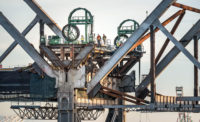Because some of the joints, known as knuckles, have up to eight plies of 1-in.-thick steel, "when you look at the outside of the knuckle, it's not readily apparent where the best cut locations are," Howe says. With BRIM, "you can create transparencies so you can see through all the layers and map where the most efficient places to cut would be."
With the plan and models in hand, CEC/Silverado began removing the upper deck and stringers to lighten the load on the bridge. After installing a rolling debris-containment system under the lower deck, crews next removed asphalt and concrete with excavators and loaders, replacing some areas with lighter timber mats to provide a work platform for equipment and two 200-ton hydraulic truck cranes.
In addition, crews assembled two tower cranes on the main piers. They allowed access to the bridge's 380-ft-tall highest members, which were out of the truck cranes' reach.
At the same time, workers threaded 76 temporary steel members through the bridge steel to resist stress redistribution during disassembly.
Before crews could begin cutting through the main structural members, stresses at the suspended span had to be reversed so that the span became extensions of the arm cantilevers. To accomplish this, crews jacked the upper chords of both trusses at each end of the suspended span, with a force of approximately 1,000 tons.
"The jacking allowed us to cut the bridge right at the center of the main span, and each remaining half would just be cantilevering out all the way back to the bridge pier," Coleman says.
On April 2 of last year, workers severed the span, creating two separate 700-ft-long cantilevers. Despite being "the most exciting, emotional day with the most determined effort leading up to it," Coleman says the cut "was really anticlimactic, which is exactly how it was engineered to be."
"But you never really know until you do it," he adds. "There are a lot of unforeseen and residual forces that could [have been] unaccounted for."
Despite the lengthy cantilevers, bridge movement due to wind or equipment was barely perceptible. "It's a testament to the sturdiness of how they built the bridge that after it was cut, it felt the same as the day before the cuts were made," says Michael McKinney, CEC's project engineer.
Next, cranes began removing the portions of the suspended span that were attached to each cantilevered arm. "We just took them apart piece by piece, day by day, and worked backward as if you were standing on a tree limb and just cutting an inch off in front of you and then taking a step back," Coleman says.
Once crews removed the cantilevered span back to the piers, additional temporary vertical supports between piers allowed demolition to continue. Meanwhile, the original steel substructure columns were removed down to water level.
Deck loads limited maximum pick weights to 50 tons. While the 3D model helped crews make precision cuts to conform to weight limits, multiple layers of paint added so much extra weight that field personnel and engineers had to make recalculations, Riggs says.
Lead paint mitigation was difficult because the plates for the layered members had been prepainted. "When you have a member that's sandwiched together with eight different thicknesses of steel, that's 16 surfaces that need to be mitigated, but you can only get to two of them," Howe says.
Fortunately, when cutting the steel with blowtorches, the prevailing northwest wind blew the toxic smoke away from traffic on the new bridge and the project was able to satisfy environmental and workplace safety regulations.
A full medical surveillance program was established and monitored, along with regularly scheduled testing of lead levels in the bloodstream of workers, Riggs says.












Post a comment to this article
Report Abusive Comment